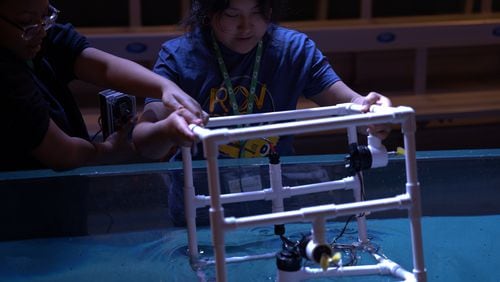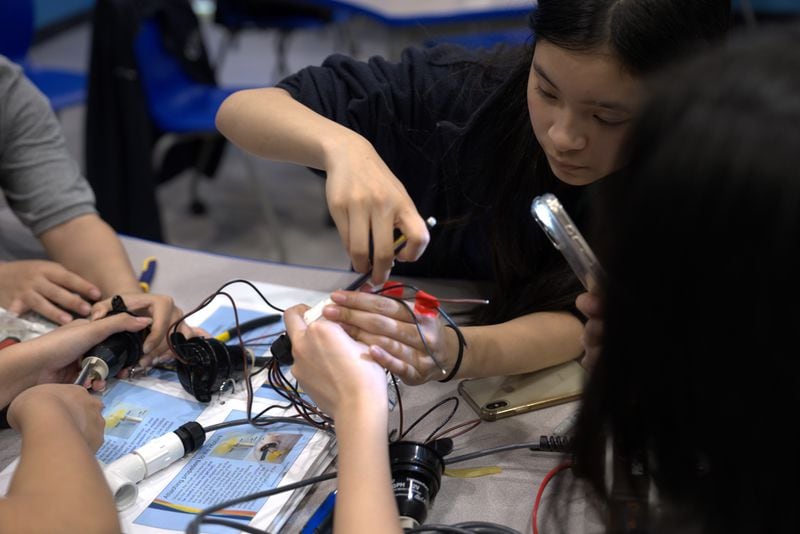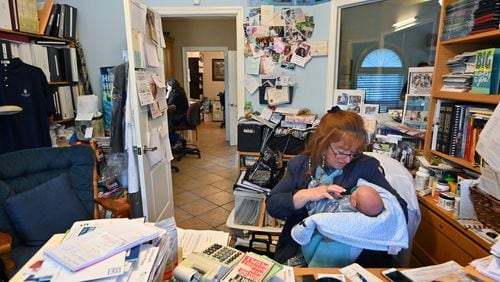It’s not unusual for students on spring break to gravitate to the water, but 16 girls from Gwinnett County’s Sweetwater Middle School spent their week off from school in a different aquatic environment.
It wasn’t total relaxation either. They were on a mission.
The girls, all seventh and eighth graders, were charged with designing remote-controlled vehicles that could maneuver around to scan an underwater environment like a reef or a seabed. Theoretically, of course. In this design and testing phase over spring break, their area of exploration was a sea lion show tank at the Georgia Aquarium — the sea lions spent this time relaxing elsewhere.
For several years, girls in the science, technology, engineering, arts and math program at Sweetwater have had the opportunity to spend five days at the aquarium, seeing STEAM in action, learning about marine sciences and doing some engineering of their own to create vehicles.
The partnership happens through a grant to support girls in STEAM, particularly girls from underrepresented backgrounds in those fields.
“They might have dreams to be scientists or doctors or engineers or astronauts, and this is sort of the age where they might quit those dreams,” said Paivi Lievonen, a Sweetwater STEAM teacher who accompanied the students at the aquarium. Factors that may cause girls to quit include not seeing as many women in those fields or feeling discouraged from pursuing those studies.
Programs like the one at the aquarium strive to maintain girls’ interest in STEAM, Lievonen said.
Seventh grader Rhylee Ford said she’s always been drawn to the water and can see herself working in marine science or engineering one day. She appreciated hearing from many women in STEAM throughout the spring break program, showing the wide variety of opportunities out there.
Credit: Courtesy of Georgia Aquarium
Credit: Courtesy of Georgia Aquarium
Rhylee said she enjoyed engineering and design projects at school, but the aquarium offered a new environment and a bigger challenge.
The vehicles were mostly made from PVC pipes and equipped with pool noodle pieces and fishing weights to get the right buoyancy. A trio of rotors controlled by remote provided the movement. The prevailing challenge among teams was calibrating the floats and weights to have their vehicles sit flat between the bottom of the tank and the water’s surface.
Similar vehicles with higher-tech components may be equipped with claws to pick up items, or lights and cameras to capture images underwater, Lievonen said. Meggie Kuehnel, assistant manager of education at the aquarium, said divers use similar vehicles in the aquarium tanks.
“The fun part about this is the teamwork, and you get to be creative,” Rhylee said. She enjoyed the process of getting to a testable vehicle. Their drawn designs evolved as they started building, considering materials and thinking about powering their vehicles.
“It’s very stressful working through problems, but the problems help you learn more,” she said.
Seventh grader Tracy Phan agreed that teamwork was a fun part, drawing laughs and a sarcastic response from her peers who were working to get their vehicle maneuvering properly after some rotor malfunctions. They later agreed that they never yelled at each other, they were just communicating loudly.
Lievonen said that’s the environment she tries to maintain. Students may be loud sometimes, but as long as they’re on topic and excited about their work, she’s fine with it.








